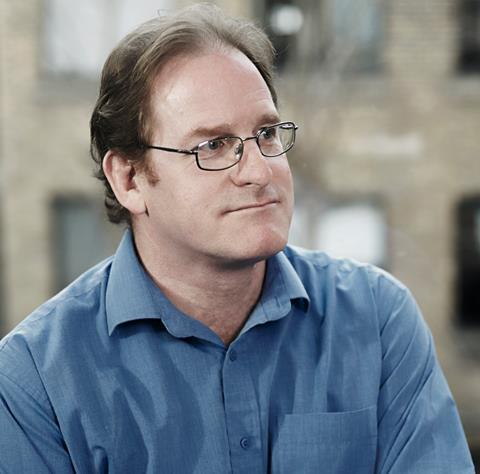
As part of our report into how architects approach product specification, we spoke to Sheppard Robson technical director Chris Jarvis, who would like to see product standards developed to be relevant for MMC
With projects ranging from laboratories to offices to its credit, Sheppard Robson is shaping the modern workplace, and working across such sectors as education, housing and healthcare. As it looks to deliver more sustainably, the practice is transferring some experience and materials across sectors, notably deploying the cross-laminated timber (CLT) used in its education projects for hybrid CLT commercial developments.

The practice has offices in London, Manchester and Glasgow, supported by a central in-house technical and specification-writing team headed by technical director Chris Jarvis.
What are the issues currently impacting on specification – and how are these changing?
In the initial stages of the pandemic we found a lot of manufacturers were struggling to provide architects with the technical support required. For performance-based specifications, we always want information from manufacturers and suppliers, but for prescriptive specifications it is absolutely essential that we get the manufacturer’s or supplier’s buy-in for the use of their products or systems in that particular location fixed in that particular way. So we are heavily dependent on them, particularly when teams are working to tight deadlines.
As a large practice, we’ve often had arrangements with suppliers for components for buildings, whereby they would provide dedicated technical support, by phone, email or coming into our office. But in the pandemic people were on furlough or working from home, understandably, and we struggled to get hold of technical support. In the main, things have been improving over recent months, but there are some manufacturers or system providers who are struggling to provide the pre-pandemic level of technical support.
Confidence in information sources varies. All have been shown to be fallible, to a greater or lesser extent
For some it may be a post-pandemic hangover; some say they are flooded with enquiries but many are wary after the Grenfell fire of providing advice that isn’t couched in caveats and disclaimers that can render it meaningless. I understand some nervousness, but we’ve got to get around this or it’s a massive roadblock in being able to confidently specify materials.
Are any design trends having an impact – if so, what?
Most significant is modern methods of construction (MMC). New MMCs are evolving, but the means of testing hasn’t changed and in many instances is wholly inappropriate for them.
Similarly, we are trying to apply CLT but it’s becoming clear that Approved Document B of the �ڶ����� Regulations and the British Standards for fire are based on the assumption that a building’s structural frame is made from non-combustible material. If you are using something that is not, such as CLT, there has to be a holistic fire-engineered approach as the guidance in the current standards and Approved Document B is not always appropriate.
Fire is the obvious risk area presenting challenges, but this applies to other areas, such as watertightness. Standards need to be developed to be relevant for MMC.

How are you responding to these specification challenges?
We’re responding in various ways. With CLT we’re working with consultants with a lot of experience in those methods of construction. We have developed roadmaps to compliance with them, which require very early consultation with clients, building control, building warranty providers and even building insurers.
Where do you turn for information on product specification issues?
We rely on manufacturers, third-party accreditation bodies like British Board of Agrément, and trade associations like Timber Research and Development Association (TRADA) and the �ڶ����� Control Alliance, which have produced guidance.
But, in the aftermath of Grenfell, we’ve found many organisations have either withdrawn or added caveats to their advice.

How confident are you in these sources of information?
Confidence in information sources varies. All have been shown to be fallible, to a greater or lesser extent.
What are the issues or topics where specification knowledge is lacking?
There’s a lack of adequate testing for some products and materials. Historically, there are instances where a certain amount of testing of products and systems has been done and that formed the basis to use them in instances that weren’t exactly how they had been tested, but it was deemed to be adequate. Now we have to be so careful. If products don’t have exactly the right test, we have to ask if we can use them, or who will take responsibility.
Certification can be confusing – the presentation of certificates for some products and the field of application are not always clear
Certification can be confusing – the presentation of certificates for some products and the field of application are not always clear. There sometimes seems to be a lack of consistency across manufacturers in how they present information.
Also, in making progress towards net zero, we find there are a lot of different carbon footprint calculators out there. Until there’s an industry standard for this, there will continue to be a significant margin of difference, depending on what tool you’re using.

What do you think would help improve knowledge on challenging specification issues – and how could manufacturers help?
Knowledge would be improved by manufacturers having the resource to give good technical guidance to allow designers to make appropriate selections.
Also, testing often falls down at the interfaces. I understand that goes beyond the application of a company’s product but, if you don’t do it, how can designers know materials will be compatible or performance maintained at a junction? If you could test a typical detail, with a field of application, that would give some comfort to the designer.
What product developments would you like to see to ease some of these challenges?
I would like to see an agreed common method of presenting the certification of products – whatever is being certified – ideally on a single sheet of A4 paper.
Intelligence from architects: Product specification report
- 1
- 2
- 3
- 4
- 5
- 6
- 7
 Currently reading
Currently readingInterview: Chris Jarvis, Sheppard Robson
- 8
- 9
- 10
- 11














No comments yet